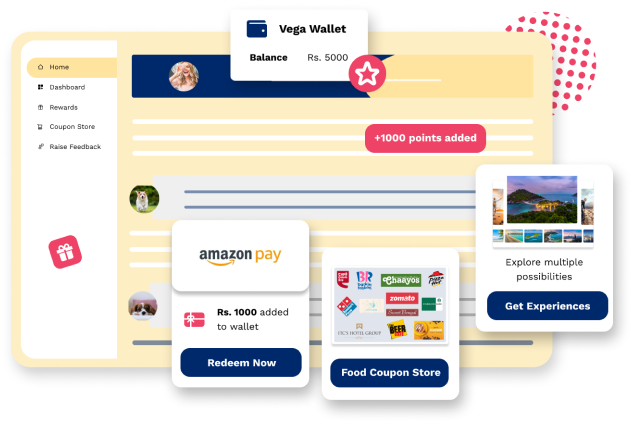Introduction
In today's dynamic and fiercely competitive business landscape, organizations are realizing that their most valuable asset goes beyond their products or services — it lies within their employees. They are the backbone of every organization and actively contribute towards a company’s growth. So, it is important to acknowledge the ideal employee experience as a success factor for a company. However, the phrase ‘employee experience’ is an amalgamation of different aspects. This means an ideal experience requires various aspects like positive work culture, employee engagement, and feedback. Focusing on experience also helps in attracting talent. According to Glassdoor, 77% of job seekers say that employee experience is a deciding factor
So, measuring employee experience means measuring the different factors it constitutes. Evaluating these factors distinctly can collectively provide us insights into the kind of experience fostered by the company’s work culture. Read on to find out about these factors and how they correlate with experience.
The Importance of a Positive Employee Experience
Positivity in the workplace creates large intangible returns that improve the company's culture overall. Employees who enjoy their jobs, appreciate their peers, and look forward to coming to work are more likely to go above and beyond to help the firm succeed. A positive employee experience acknowledges each employee's value, dignity, and worth, which benefits both the individual and the organisation.
Negative employee experiences breed resentment, disinterest in improving performance, and a desire to stay with the organisation in the long run.
As employee experience is an amalgamation of various factors, each factor is distinct and equally important. To create an overall positive employee experience, these metrics need to be paid attention to and evaluated consistently:
Key Metrics to Evaluate when Measuring Employee Experience
The factors that constitute experience are a mix of qualitative and quantitative factors. The metrics mentioned in this blog are a combination of both, as they are very important in the context of overall employee experience -
Importance of Employee Satisfaction
Employee satisfaction is a crucial metric in evaluating employee experience as it directly reflects the level of contentment and fulfillment employees derive from their work and the overall workplace environment.
There are many ways to quantify employee satisfaction. Ask employees to rate how satisfied they are on a scale, preferably from 1-5 (The scale can be categorized into very satisfied, satisfied, neutral, dissatisfied, and very dissatisfied). With this data in hand, implement the formula below -
Employee Satisfaction Score = (Sum of Satisfaction Ratings for All Employees) /
(Total Number of Employees)
For example, if an organization uses a numerical scale from 1 to 5 and has 100 employees, and the sum of all satisfaction ratings is 350, the calculation would be:
Employee Satisfaction Score = 350 / 100 = 3.5
This KPI for measure employee experience gives qualitative data on how team members feel in general at work. More specifically, the employee satisfaction metric assesses your team members' levels of happiness with their function in the organisation, salary, and the overall environment.
Employee Net Promoter Score (eNPS)
Employee net promoter score (eNPS) is a metric that measures employees' willingness to recommend their organisation to others in order to determine job satisfaction. It assesses their loyalty and engagement, as satisfied and engaged employees are more likely to become advocates for their organization.
Here’s how it is calculated -
eNPS more often than not consists of this question -
‘On a scale of zero to ten, how likely is it that you would recommend working for our company?’
After employees rate their company, HR divides them into:
- ‘Promoters’ – (9-10)
- ‘Passives’- (7-8)
- ‘Detractors’ – (0-6)
eNPS = % of Promoters (employees who are highly likely to recommend) - % of
Detractors (employees who are highly unlikely to recommend)
Anything between 10 and 20 is reasonable, between 20 and 30 is good, and 40 to 50 is outstanding.
By subtracting the percentage of detractors from the percentage of promoters, organizations can gauge the overall sentiment of employees and their willingness to recommend the organization. A positive eNPS indicates a higher level of employee satisfaction and loyalty, while a negative eNPS signals potential areas for improvement and areas of dissatisfaction.
Employee Productivity & Performance
Employee productivity measures the output and efficiency of employees in completing their tasks and responsibilities. It assesses how effectively employees utilize their time, skills, and resources to achieve organizational goals. And it ties directly with employee experience too - According to a study by the Saïd Business School of Oxford University, employees who are happy at work are, on average, 13% more productive than their counterparts.
Since every employee has a different role in an organization, it can become quite tricky to set one formula to calculate every one’s productivity. But they can use this template formula and substitute its elements with different variables, like time spent, projects worked on or whatever metric can define the work done by that employee. Here is the formula -
Employee Productivity = (Total Output / Total Input) x 100
For example, if an employee is expected to complete 10 projects in a month but only completes 8 projects, the calculation would be:
Employee Productivity = (8 / 10) x 100 = 80%
This indicates that the employee achieved 80% of the expected output.
Setting measurable goals on a quarterly or yearly basis and periodically monitoring your team's progress is a great way to gauge your team's productivity. When goals are frequently met or even exceeded in a department, it indicates a positive and motivating employee experience.
How to Improve Employee Retention?
It is no secret that a high retention rate is a sign of positive employee experience and an ideal work culture. You can keep employees productive and contribute to the overall success of the company by ensuring that they are happy with their work environment. Employees that have been with the company for a long time have a wealth of institutional knowledge; if they go, you must rebuild it with a replacement. According to the Society for Human Resource Management, replacing an employee can cost a company up to nine months' income.
So, retaining employees for the long term is a key strategy for every company looking to build a positive work culture. Here is how you can calculate retention -
Employee Retention = (number of employees at the end of the year ÷ number of
employees at the beginning of the year) x 100
For example, an employer that started the quarter with 100 employees and ended with 95 of would have a retention rate of 95%.
Effect of Absenteeism on Employee Performance
It is vital to keep absenteeism rates as low as possible to maximize both profitability and employee engagement. Absenteeism can have a huge impact on productivity and can force a company to spend a lot more. When an employee is absent for non-urgent reasons, the pressure on other employees increases, affecting their performance and creating a dangerous cycle.
An overworked team can be worn out, stressed, and more prone to illness. If the atmosphere at work deteriorates, an employee could simply take a sick day to avoid conflict. Here is how absenteeism can be calculated -
Absenteeism rate = (number of absences ÷ total number of workdays in a year) x 100
A low absenteeism rate (the closer to zero, the better) indicates a positive employee experience.
Are you Ready to Enhance your Employee Experience?
With Vega HR, foster a work culture that brings the best out of your employees by creating the most positive and uplifting environment
Customer Ratings
If your customers have a positive impression of your firm and desire to return, it's most likely due to the excellent work your employees accomplished to sell your product or service. Positive customer ratings also reflect a positive employee experience, indicating that employees are delivering exceptional service and creating positive interactions, and contributing to a favorable customer experience.
Keeping track of customer ratings, customer service ratings, customer satisfaction ratings, and other comparable data is an excellent approach to round out your employee experience evaluation, and can also help identify areas for improvement, implement targeted training and development programs, and enhance the overall employee and customer experience.

Different Ways to Collect Insights on Experience
Employee Experience Surveys
Employee experience surveys enable you to collect timely and targeted feedback from your employees. You can send out short surveys throughout the year as an addition to a larger annual survey, providing consistent perspective. This also allows you to identify any issues related to your employee experience as they arise, rather than learning about them all at the end of the year.
You can also tailor surveys to certain parts of your employee experience if you want to understand more about them. A brief onboarding survey for any new hires, for example, might help you fine-tune a vital element of your employees' experiences.
The greatest benefit of employee surveys is that they allow for two-way dialogue. A strong employee experience prioritizes discussion and transparency over traditional top-down communication, and surveys are an easy method to accomplish this.
Here are a few surveys that can be employed to understand employees better
Rewards and Recognition Programs
Implementing a rewards and recognition program is a great way to collect information. An R&R platform like Vega HR consistently helps companies gather data and display it in the form of interactive dashboards, along with providing customized reports. These insights offer a glimpse of the work culture and what areas can be improved if needed.
An R&R program can help measure the employee experience. It helps create a work culture that promotes prompt feedback, and consistent recognition and enhances overall well-being, amongst many other advantages
Focus Groups
Focus groups are another method of gauging employee experience. While employee surveys are a useful approach to getting quantitative data, a focus group can assist management gather more detailed information on how employees feel about specific events in the organisation.
Focus groups are often arranged to check employees’ pulse following a major change in the company. In some companies, however, employee focus groups are held instead of surveys and are done regularly.
In order to gain more objective results, managers are generally excluded from focus groups. The coordinators play a vital role in every focus group, as they are in charge of taking comprehensive notes and organising the meeting's logistics. Finally, the employees are the most significant participants in a focus group: typically, a focus group comprises 6 to 12 individuals.
Focus groups offer a powerful means of measuring employee experience by facilitating rich and in-depth discussions. They provide a platform for participants to openly share their thoughts, opinions, and experiences, allowing organizations to gain a deeper understanding of the employee experience beyond quantitative metrics.
Conclusion
It is important to identify metrics and benchmarks before implementation. Along with this, fixate on the ideal scale for employee surveys and feedback. Pairing the right metric with the right method of collecting data on that aspect helps establish a clear process and sets a plan of action.
All in all, though experience can be measured in many ways, companies must ensure that they listen to their employees too. Sometimes, even a candid conversation can provide real-time insights. This is a consistent process.
About Vega HR
Vega-HR is a powerful tool in the talent war, offering employee rewards, recognition, and pulse recognition. With an engaging platform, it fosters a world-class work culture, providing P2P recognition, social feedback, on-spot recognition, and monetizable incentive solutions with 3000+ coupons in various categories.
Create a Culture People Want to Stick to
- Send rewards
- Give shoutouts
- Build a community
- Gift experiences
Get a demo
 Written by Varshith Mittapalli 27 July 2023 | 4 min read
Written by Varshith Mittapalli 27 July 2023 | 4 min read





